- Home
- Listings
- Things To See & Do
- Car Hire
- News
- Properties
- What’s On
ES
Almuñécar
Exploring the Charms of Almuñécar: A Spanish Coastal Gem
Nestled along the picturesque Costa Tropical in the province of Granada, Spain, lies the enchanting town of Almuñécar. This hidden gem is a destination that effortlessly marries history, natural beauty, and vibrant culture. From its ancient Moorish roots to its sun-kissed beaches and lively festivals, Almuñécar promises an unforgettable experience for every traveler.
Historical Tapestry:
The first settlers of Almuñécar, Spain, date back to ancient times. This coastal town, located in the province of Granada, has a rich history that traces its origins to the Phoenicians, who established a trading post here around 800 BC. They were followed by the Carthaginians, who further developed the area as a strategic port.
During the Roman period, Almuñécar, known as “Sexi Firmum Iulium,” became an important city in the region. The Romans left behind significant architectural and cultural remnants, including an aqueduct, a fish salting factory, and thermal baths, which are still visible today.
In the 5th century, as the Roman Empire weakened, the Visigoths took control of the area, followed by the Byzantines. However, it was the Moors who left an indelible mark on Almuñécar’s culture and architecture. They ruled the region for nearly 800 years, constructing fortifications, irrigation systems, and the Castle of San Miguel, which stands as a prominent landmark. Perched on a hilltop overlooking the town, this ancient fortress provides panoramic views of the Mediterranean Sea and the surrounding landscape. Wander through its well-preserved walls and transport yourself back in time to the days of Moorish rule and medieval battles.
In 1489, Almuñécar was captured by the Catholic Monarchs, Ferdinand and Isabella, marking the end of Moorish rule in the region. The town experienced a period of Christianization and reconstruction, with the conversion of the former mosque into the Church of the Incarnation.
Today, Almuñécar blends its ancient past with modern amenities, drawing visitors to its beautiful beaches, archaeological sites, and charming old town, providing a glimpse into its diverse and captivating history.
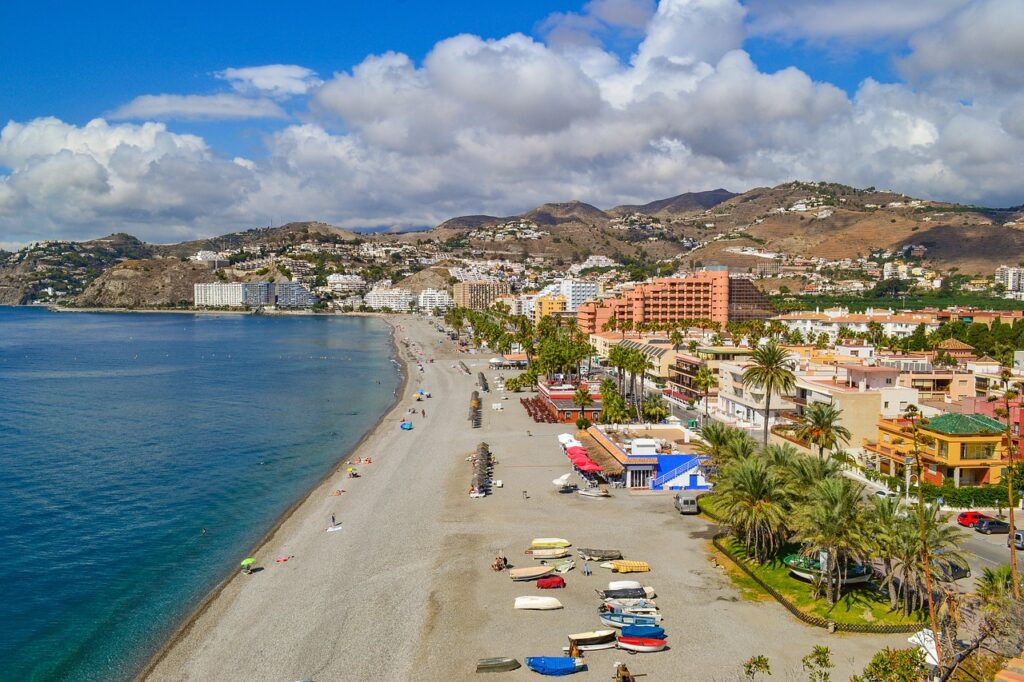
Sun-Drenched Beaches:
Almuñecar boasts a variety of stunning beaches, providing ample opportunities for leisure and relaxation amidst picturesque coastal scenery. Playa de San Cristóbal and Puerta del Mar are long urban beaches that offer convenient amenities such as beachside restaurants, showers, and rental facilities, ensuring a comfortable seaside experience for all. Venturing further along the coastline reveals hidden gems like Velilla or Cabria. If you’re looking for a more secluded spot, Playa del Muerto offers a naturist-friendly atmosphere and crystal-clear waters, perfect for snorkeling and swimming. With its diverse array of beaches catering to every preference, Almuñecar provides the perfect destination for a memorable seaside escape along the Costa Tropical.
Culinary Delights:
Almuñécar’s culinary scene is a delightful blend of traditional Andalusian flavors and fresh seafood. The town’s proximity to the sea ensures that you’ll find an abundance of seafood restaurants along the waterfront, offering dishes that celebrate the region’s maritime bounty. Indulge in grilled sardines, paella, and the renowned “pescaíto frito” (fried fish), accompanied by a glass of local wine or sangria.
Festivals and Traditions:
Throughout the year, Almuñécar comes alive with vibrant festivals that showcase its cultural heritage. The Semana Santa (Holy Week) processions, held in the spring, are a deeply rooted tradition featuring elaborate floats, religious processions, and solemn ceremonies. In the summer, the town bursts with color and energy during the Fiestas de Agosto, a week-long celebration featuring live music, dance performances, and fireworks that light up the night sky.
Exploring Nature:
Beyond its historical and cultural attractions, Almuñécar offers nature enthusiasts a wealth of opportunities. The Natural Reserve of Maro-Cerro Gordo, located just east of the town, boasts hiking trails that wind through lush Mediterranean vegetation, revealing hidden coves and stunning vistas.
Charming Old Town:
Stroll through Almuñécar’s charming Old Town, where narrow streets wind their way between white-washed houses adorned with flower-filled balconies. The bustling market square is the heart of the town, offering a glimpse into daily life as locals gather to shop for fresh produce and crafts.

Practical Information:
The town’s mild Mediterranean climate makes it a year-round destination, with warm summers and pleasant winters. Accommodation options abound, from cozy guesthouses to beachfront hotels, ensuring that every traveler finds a comfortable retreat.
Almuñécar is a treasure trove of history, culture, and natural beauty waiting to be discovered. Whether you’re a history enthusiast, a beach lover, or someone who simply wants to immerse themselves in the charm of a Spanish coastal town, Almuñécar promises an unforgettable journey filled with authentic experiences and lasting memories.
You may also be interested in:
Places to visit in Almuñécar
Almuñécar Castle – San Miguel Castle

The most famous historic site on the area. Perched on the San Miguel Hill, with commanding views of Almuñécar, this Arab stronghold occupies a site once utilized by Phoenicians and Romans, evident from various historical sources and remnants of Roman constructions. The castle’s architecture distinctly reflects its Moorish origins, having served as a retreat for the Nasrid dynasty during the 13th century. In the later years of King Ferdinand’s reign in the 16th century, defensive enhancements including a moat, drawbridge, and an imposing entrance façade with four circular towers were added. The castle endured bombardment during the War of Independence against the French by English forces, leaving it in a state of disrepair. It later functioned as a Christian cemetery until the mid-20th century. Notably, a neoclassical pavilion, seemingly unrelated to the castle’s design and possibly constructed in the 18th century, now houses the City Museum.
Botanical-Archaeological Park El Majuelo

El Majuelo Park is a haven of natural beauty and biodiversity nestled in the centre of Almuñécar. El Majuelo covers an area of nearly 5 hectares. Here, visitors of all ages can immerse themselves in a world of fascinating flora and tranquil surroundings.
Explore over 180 species of plants, including rare and exotic varieties, carefully curated to showcase the rich biodiversity found in tropical regions around the world. Here, species from Argentina, Peru, Cuba, Brazil, and other countries in Central and South America coexist with plants originating from Polynesia, New Zealand, Melanesia, Malaysia Islands, Micronesia, Africa, the Philippines, Madagascar, Indonesia, New Guinea, Australia, China, India, Arabia, and even Japan.
Inside El Majuelo you can also visit the Roman Fish Salting factory. Find more information in our Historic sites page.
Sculpture park: visit the open air gallery of more than 30 sculptures by modern sirian artists.
Throughout the year various cultural events take place: music concerts, stand-up comedy shows, craft fairs, and magic performances are some of the activities you can enjoy throughout the year, but especially during the summer.
El Majuelo is situated at the foot of San Miguel Castle and just a few meters from San Cristóbal Beach.
It is open everyday between 9am and 23pm.
Free admission
El Majuelo fish salting factory
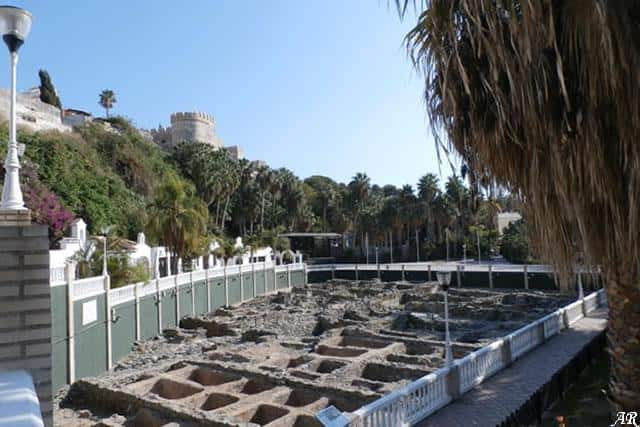
The El Majuelo fish salting factory in Almuñécar is an important archaeological site that highlights the region’s Roman and Phoenician heritage. Located in El Majuelo Botanical-Archaeological Park, this ancient facility was key to fish processing and the production of garum, a prized Roman fish sauce. The factory dates back to the 4th century BCE, with peak activity during the 1st and 2nd centuries CE. Its strategic location near the port yet away from the city minimized odors while ensuring efficient operations. Visitors can explore the preserved salting tanks and learn about Almuñécar’s historical significance in ancient Mediterranean trade.
The factory’s design included central tanks for salting fish, cleaning and storage areas, and administrative spaces. Fresh water was supplied through an aqueduct system, and the tanks were waterproofed using opus signinum, a Roman sealing material. By the 4th century CE, the factory’s use declined, eventually becoming a burial site. Today, visitors can enjoy free access to the site, which is open daily, and experience a fascinating glimpse into Almuñécar’s industrial past and the broader economic activities of the Roman Empire.
Almuñécar Roman aqueduct
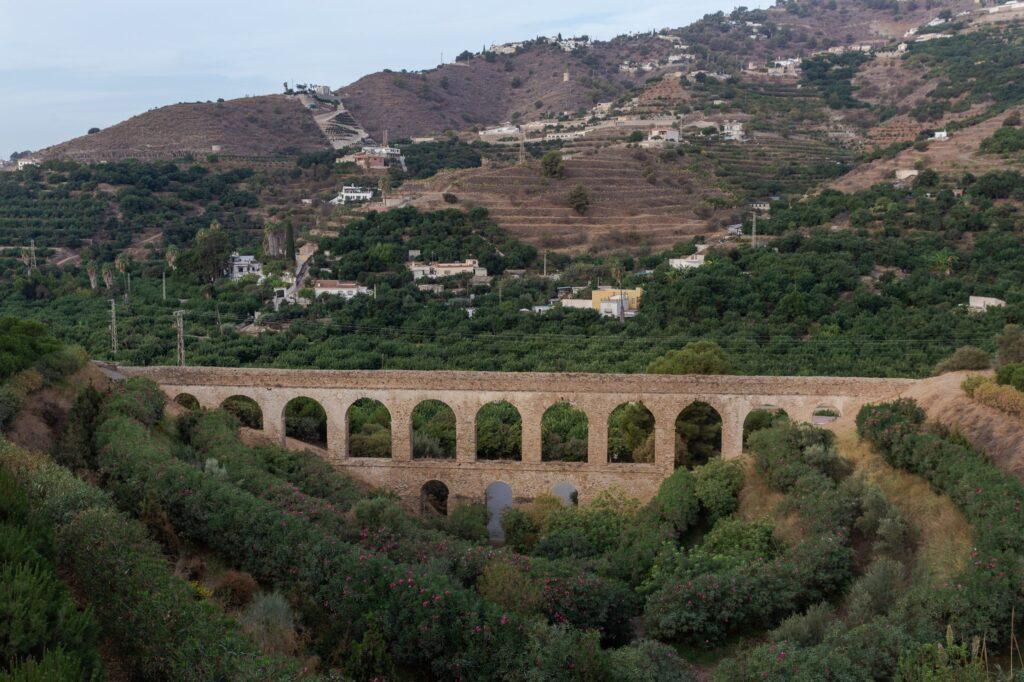
The Roman aqueduct in Almuñécar, built around the 1st century CE, is a remarkable testament to the city’s Roman heritage, alongside the well-preserved fish salting factory. This aqueduct served as a vital water supply for the ancient Roman city of Sexi (now Almuñécar), and later played a role in the Arab irrigation system. Even today, parts of it continue to support traditional irrigation practices, making it the best-preserved Roman aqueduct in Andalusia.
This aqueduct is quite extensive, spanning over 7 kilometers and divided into five distinct sections. Visitors can explore five preserved sections of the aqueduct, including notable stretches like Torrecuevas, La Carrera, and Río Seco. The Carrera section features 12 arches spanning 91 meters, while the Torrecuevas segment, near Río Verde, extends 130 meters and includes the tallest visible portion. Río Seco sections offer stunning countryside views, with arches ingeniously adapted to the natural terrain. The most accessible part is in Carrera de la Concepción, integrated into the town alongside Roman baths. Access to most sections is free, with Parque del Acueducto open from 9 am to 9 pm.
Almuñécar Roman Baths
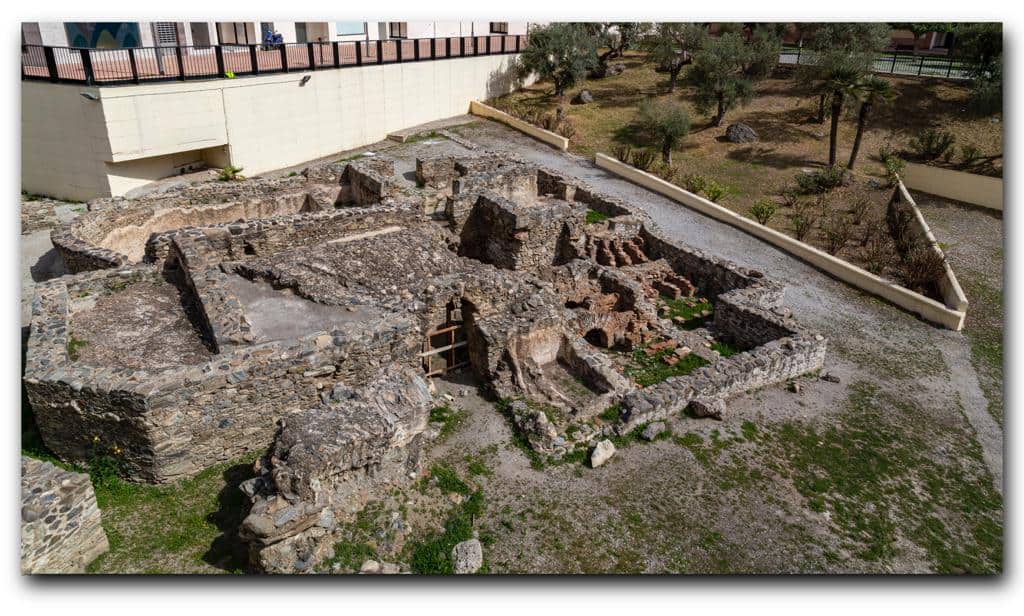
The Roman Baths of Almuñécar, also known as “Termas Romanas,” stand as a remarkable testament to the ancient Roman presence in this coastal town of southern Spain. Situated in the heart of Almuñécar’s historic center, these well-preserved baths offer a fascinating glimpse into the daily life and customs of the Roman inhabitants who once occupied this area.
Believed to have been constructed during the 1st century CE, the Roman Baths are a testament to the advanced engineering and architectural skills of the Romans. This thermal complex served as a vital social and recreational hub for the citizens of Sexi, the Roman name for Almuñécar. Here, residents would gather to relax, socialize, and partake in various health and wellness rituals.
The layout of the baths follows the traditional Roman pattern, comprising different chambers dedicated to specific stages of bathing. Visitors would start in the “caldarium,” a hot room where steam and warm air were used to induce sweating and open pores. This was followed by the “tepidarium,” a warm room, and then the “frigidarium,” a cold room, providing a gradual transition to cooler temperatures. Adjacent to these chambers were spaces for exercise and massage, as well as rooms for socializing.
The architecture of the Roman Baths showcases the Romans’ mastery in utilizing materials like brick and mortar, along with ingenious methods for heating the spaces. The hypocaust system, an underfloor heating system, circulated hot air through the walls and floors to maintain a consistent temperature within the baths.
Today, visitors to the Roman Baths of Almuñécar can explore the well-preserved remains of this ancient complex. The site is thoughtfully curated, with informative displays providing historical context and insights into the Roman bathing customs. As you walk through the chambers, you can envision the bustling activity that once took place here, and admire the architectural details that have stood the test of time.
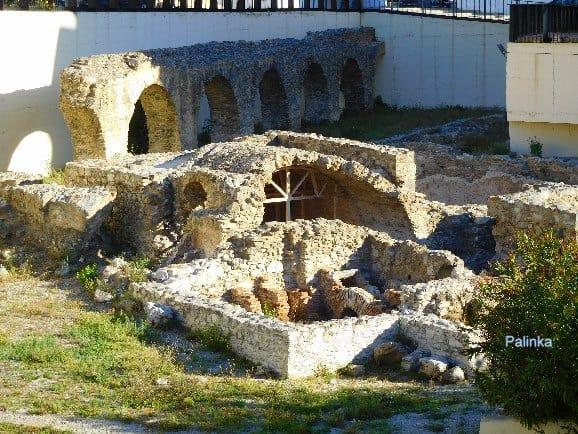
There are regular guided visits organised by the Town Hall. Check their website for details
Cave of Seven Palaces Archeological Museum
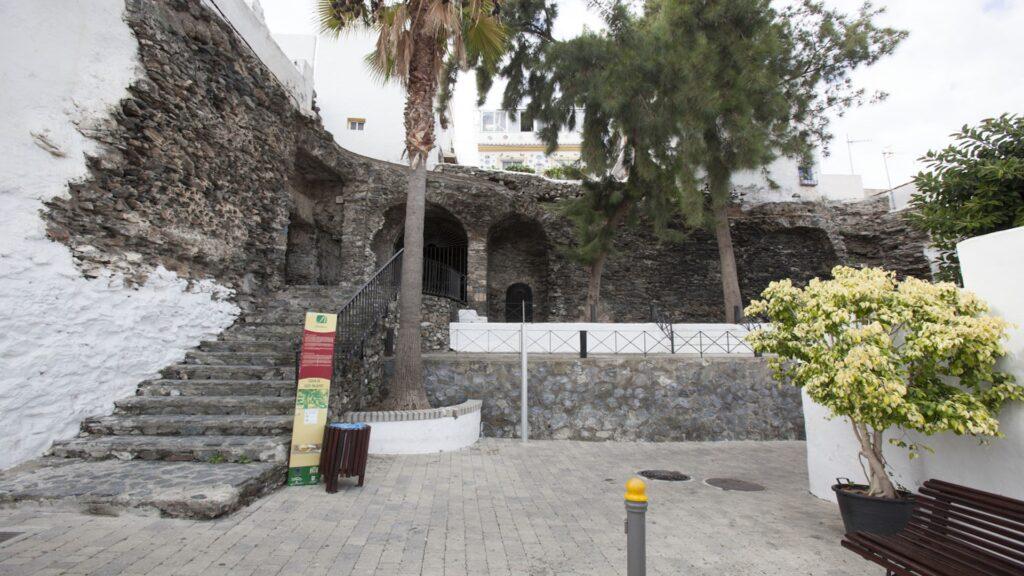
The site of this museum was once the basement of a large Roman construction, possibly a temple to honour the goddess Minerva. In its interior, the visitor can admire some of the fascinating historical remains of Almuñcar, such as the collection of objects from the Necropolis of Puente de Loy and Laurita, and a seventeenth-century BC Egyptian vase sculpted from solid quartz.
Open: Summer (July 1st through September 15th): Tuesday to Saturday 10am to 1:30pm / 6:30pm to 9pm. Sunday 10am to 1pm. Spring and autumm (April 1st through June 30th and September 16th through October 30th): Tuesday to Saturday 10am to 1:30pm / 5pm to 7:30pm. Sunday 10am to 1pm. Winter: November 1st through March 31st: Tuesday to Saturday 10am to 1:30pm / 4pm to 6:30pm. Sunday 10am to 1pm. Closed all day Monday, and Sunday afternoon.
Address: Cueva de los Siete Palacios, calle Eras del Castillo 29, 18690, Almuñécar. Tel: 958 61 61 31. Email: culturalmunecar@almunecar.es.
The Necropolis of Puente de Noy

Another historic landmark of Almuñécar is the Phoenician Necropolis of Puente de Noy. This important archaeological site, active from the 7th century BC to the 1st century AD, reveals the burial practices and rituals of the Phoenician colony of Sexi. Since its discovery in 1979, over 200 tombs containing burial goods, jewelry, and various other artefacts have been uncovered, underscoring the site’s historical and archaeological significance in the region. The site also highlights the fascinating cross-cultural influences between the Phoenicians, Romans, and other Mediterranean civilizations of the time. Located on a hill west of the Río Seco, the necropolis can be accessed by car by driving west from the city centre via the Puerta de Granada street, heading towards the institute. Alternatively, it’s possible to go on foot. While it currently lacks extensive visitor services, it remains an essential stop for anyone interested in exploring Almuñécar’s ancient Phoenician heritage.
